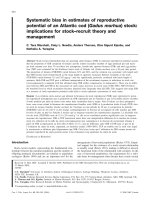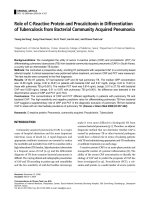Bariatric Surgery in Women of Reproductive Age: Special Concerns for Pregnancy pot
Bạn đang xem bản rút gọn của tài liệu. Xem và tải ngay bản đầy đủ của tài liệu tại đây (312.08 KB, 77 trang )
Evidence Report/Technology Assessment
Number 169
Bariatric Surgery in Women of Reproductive Age:
Special Concerns for Pregnancy
Prepared for:
Agency for Healthcare Research and Quality
U.S. Department of Health and Human Services
540 Gaither Road
Rockville, MD 20850
www.ahrq.gov
Contract No. 290-02-0003
Prepared by: Southern California Evidence-based Practice Center (EPC), Santa Monica, CA
Evidence-Based Practice Center Director
Paul G. Shekelle, M.D., Ph.D.
Project Manager
Margaret Maglione, M.P.P.
Literature Reviewers /Content Experts
Zhaoping Li, M.D.
Melinda Maggard, M.D.
Irina Yermilov, M.D.
Medical Editor
Sydne Newberry, Ph.D.
AHRQ Publication No. 08-E013
November 2008
Programmer
Lara Hilton, B.A.
Statistician
Marika Suttorp, M.S.
Database Manager
Jason Carter, B.A.
Staff Assistants
Susan Chen, B.A.
Carlo Tringale, B.A.
Breanne Johnsen, B.A.
Programmer
Lara Hilton, B.A.
Statistician
Marika Suttorp, M.S.
Database Manager
Jason Carter, B.A.
Staff Assistants
Susan Chen, B.A.
Carlo Tringale, B.A.
Breanne Johnsen, B.A.
This report is based on research conducted by the Southern California Evidence-based Practice
Center (EPC)–RAND Corporation, under contract to the Agency for Healthcare Research and
Quality (AHRQ), Rockville, MD (Contract No. 290-02-0003). The findings and conclusions in this
document are those of the author(s), who are responsible for its content, and do not necessarily
represent the views of AHRQ. No statement in this report should be construed as an official
position of AHRQ or of the U.S. Department of Health and Human Services.
The information in this report is intended to help clinicians, employers, policymakers, and others
make informed decisions about the provision of health care services. This report is intended as a
reference and not as a substitute for clinical judgment.
This report may be used, in whole or in part, as the basis for the development of clinical practice
guidelines and other quality enhancement tools, or as a basis for reimbursement and coverage
policies. AHRQ or U.S. Department of Health and Human Services endorsement of such derivative
products may not be stated or implied.
ii
This document is in the public domain and may be used and reprinted without permission except
those copyrighted materials noted for which further reproduction is prohibited without the
specific permission of copyright holders.
Suggested Citation:
Maggard M, Li Z, Yermilov I, Maglione M, Suttorp M, Carter J, Tringale C, Hilton L, Chen S,
Shekelle P. Bariatric Surgery in Women of Reproductive Age: Special Concerns for Pregnancy.
Evidence Report/Technology Assessment No. 169. (Prepared by the Southern California
Evidence-based Practice Center under Contract No. 290-02-003). Rockville, MD: Agency for
Healthcare Research and Quality. November 2008.
No investigators have any affiliations or financial involvement (e.g., employment,
consultancies, honoraria, stock ownership or options, expert testimony, grants or patents
received or pending, or royalties) that conflict with material presented in the report.
iii
Preface
The Agency for Healthcare Research and Quality (AHRQ), through its Evidence-Based
Practice Centers (EPCs), sponsors the development of evidence reports and technology
assessments to assist public- and private-sector organizations in their efforts to improve the
quality of health care in the United States. The EPCs systematically review the relevant scientific
literature on topics assigned to them by AHRQ and conduct additional analyses when
appropriate prior to developing their reports and assessments.
To bring the broadest range of experts into the development of evidence reports and health
technology assessments, AHRQ encourages the EPCs to form partnerships and enter into
collaborations with other medical and research organizations. The EPCs work with these partner
organizations to ensure that the evidence reports and technology assessments they produce will
become building blocks for health care quality improvement projects throughout the nation. The
reports undergo peer review prior to their release.
AHRQ expects that the EPC evidence reports and technology assessments will inform
individual health plans, providers, and purchasers, as well as the health care system as a whole,
by providing important information to help improve health care quality.
We welcome written comments on this evidence report. They may be sent to: Director,
Center for Outcomes and Evidence, Agency for Healthcare Research and Quality, 540 Gaither
Road, Rockville, MD 20850, or by email to .
Carolyn M. Clancy, M.D.
Director
Agency for Healthcare Research and Quality
Beth A. Collins Sharp, R.N., Ph.D.
Director, EPC Program
Agency for Healthcare Research and Quality
Jean Slutsky, P.A., M.S.P.H.
Director, Center for Outcomes and Evidence
Agency for Healthcare Research and Quality
Mary P. Nix, M.S., M.T. (ASCP) S.B.B.
EPC Program Task Order Officer
Agency for Healthcare Research and Quality
Mary P. Nix, M.S., M.T. (ASCP) S.B.B.
EPC Program Task Order Officer
Agency for Healthcare Research and Quality
Mary P. Nix, M.S., M.T. (ASCP) S.B.B.
EPC Program Task Order Officer
Agency for Healthcare Research and Quality
iv
v
Structured Abstract
Context: The use of bariatric surgery for treating severe obesity has increased dramatically over
the past 10 years; about half of patients who undergo these procedures are women of
reproductive age. This report was commissioned to measure the incidence of bariatric surgery in
this population and review the evidence on the impact of bariatric surgery on fertility and
subsequent pregnancy.
Objectives: To measure the incidence of contemporary bariatric surgery procedures in women
age 18-45 and to assess its impact on fertility, contraception, prepregnancy risk factors, and
pregnancy outcomes, including those of neonates.
Data Sources and Study Selection: We used the Nationwide Inpatient Sample (NIS), a national
sample of over 1,000 hospitals, to measure the trend in the number of women of reproductive age
who underwent bariatric procedures from 1998-2005. We searched numerous electronic
databases, including Medline and Embase, for potentially relevant studies involving bariatric
surgery (gastric bypass, laparoscopic adjustable gastric band, vertical-banded gastroplasty,
biliopancreatic diversion), and consequent fertility, contraception, pregnancy, weight
management, maternal outcomes, neonatal outcomes, and nutritional deficiencies. We scanned
reference lists for additional relevant articles and contacted experts in the fields of bariatric
surgery and obstetrics/gynecology (OB/GYN).
Of 223 screened articles, we accepted 57 that reported on fertility following surgery (19
articles), contraception use/recommendations (11), maternal weight or nutrition management
(28), maternal outcomes including morbidity and mortality (48), cesarean-section rates (16), and
neonatal outcomes (44). These articles included reports on gastric bypass, both open and
laparoscopic (27 articles), laparoscopic adjustable band (15), biliopancreatic diversion (16), and
vertical-banded gastroplasty (6). Studies could contribute to one or more analyses.
We found one case-control study and the observational data accepted included 12 cohort
studies, 21 case series, and 23 individual case reports.
Data Extraction: We abstracted information about study design, fertility history, fertility
outcomes, prepregnancy weight loss, nutritional management, outcomes following pregnancy,
and adverse events (during pregnancy) related to surgery.
Data Synthesis: Nationally representative data showed a six-fold increase in bariatric surgery
inpatient procedures from 1998 to 2005. Women age 18-45 accounted for about half of the
patients undergoing bariatric surgery; over 50,000 have these procedures as inpatients annually.
An unknown number have outpatient bariatric procedures.
We identified one case-control study that directly addressed some of the key questions, but
no randomized controlled trials or prospective cohort studies, which would be the strongest study
designs to answer questions about effectiveness, risk and prognosis. Consequently, all of our
conclusions are limited by the available data, and are cautious.
The evidence suggests that bariatric surgery results in improved fertility; the strongest
evidence is in women with the polycystic ovarian syndrome, where biochemical studies showing
normalization of hormones after surgery support case series data. Observational studies
(retrospective cohorts and case series) suggest that fertility improves following bariatric
vi
procedures and weight loss; similar to that seen when obese women lose weight through
nonsurgical means. There is almost no evidence on post-surgical contraceptive efficacy or use.
Research is needed to determine whether differences in absorption, particularly for oral
contraceptives, affect contraceptive efficacy.
Nutrient deficiencies were reported in infants born to women who underwent procedures that
resulted in malabsorption, as well as women who did not take prenatal vitamins or had difficulty
with their own nutrition (i.e., from chronic vomiting). Literature suggests that gastric bypass and
laparoscopic adjustable band procedures confer only minimal, if any, increased risk of nutritional
or congenital problems if supplemental vitamins are taken and maternal nutrition is otherwise
adequate. Biliopancreatic diversion has an appreciable risk for nutritional problems in some
patients.
Women who have undergone bariatric surgery may have less risk than obese women for
certain pregnancy complications such as gestational diabetes, preeclampsia, and pregnancy-
induced hypertension. There is no evidence that cesarean section rates and delivery
complications are higher in the post-surgery group, but data are limited.
Conclusions: Weight loss procedures are being performed more frequently to treat morbid
obesity, with a six-fold increase over a recent 7-year time span; almost half of all patients are
women of reproductive age. The level of evidence on fertility, contraception, and pregnancy
outcomes is limited to observational studies. Data suggest that fertility improves after bariatric
surgical procedures, nutritional deficiencies for mother and child are minimal, and maternal and
neonatal outcomes are acceptable with laparoscopic adjustable band and gastric bypass as long
as adequate maternal nutrition and vitamin supplementation are maintained. There is no evidence
that delivery complications are higher in post-surgery pregnancies.
vii
Contents
Executive Summary 1
Evidence Report 7
Chapter 1. Introduction 9
Surgery Produces Substantial Weight Loss 9
Bariatric Surgical Procedures 9
Rates of Surgery are on the Rise 11
Majority of Cases are Performed in Women 11
Chapter 2. Methods 13
Original Proposed Key Questions 13
Technical Expert Panel 13
Literature Search 13
Article Review 14
Study Inclusion 14
Screening 15
Data Abstraction & Synthesis of Results 15
Analysis of Trends in Surgery Utilization 15
Peer Review 17
Chapter 3. Results 19
Description of the studies 19
KQ1: What is the incidence of bariatric surgery in women of reproductive age?
What are the trends in incidence of bariatric surgery in women of reproductive
age? 21
KQ2: What is the evidence that bariatric surgery affects (directly or indirectly)
future fertility? 23
KQ3: What is the evidence that bariatric surgery affects (directly/indirectly)
choice of contraception? 27
KQ4: In patients who have had bariatric surgery, what is the evidence for
prenatal risk factors (e.g., of reduced nutrient absorption, unusual weight gain)
that may result in poor pregnancy outcomes? 28
KQ5: What is the evidence that certain management strategies for addressing
nutrient absorption and weight gain reduce the risks of poor pregnancy
outcomes? 28
KQ6: For women who have had bariatric surgery, what is the evidence for
morbidity and mortality risks for: a) mother and b) neonate? 31
KQ7: What is the evidence that cesarean section for women who have had
bariatric surgery affects the risks of morbidity and mortality for: a) mother and
b) neonate? 43
viii
Chapter 4. Discussion 43
Limitations 43
Publication Bias 43
Study Quality 43
Conclusions 43
Future Research 45
References 47
Tables
Table 1. Bariatric surgical procedures by ICD-9 code 17
Table 2. Number of inpatient bariatric procedures 22
Table 3. Cohort studies reporting on fertility 26
Table 4. Cohort studies reporting morbidity and mortality with laparoscopic adjustable band 32
Table 5. Case series reporting morbidity and mortality with laparoscopic adjustable band 33
Table 6. Cohort studies reporting morbidity and mortality with gastroplasty and
gastric bypass 35
Table 7. Case Series reporting morbidity and mortality with gastroplasty and gastric bypass 37
Table 8. Cohort Studies reporting morbidity and mortality for biliopancreatic diversion 39
Table 9. Case Series reporting morbidity and mortality for biliopancreatic diversion 40
Figures
Figure 1. Literature Flow Diagram. 20
Figure 2. Trend in Bariatric Procedures 23
Appendixes
Appendix A. Technical Expert Panel and Peer Reviewers
Appendix B. Search Strategies
Appendix C. Data Collection Forms
Appendix D. Evidence Table
Appendix E. Rejected Titles
Evidence Tables and other Appendixes are provided electronically at
1
Executive Summary
Introduction
Obesity has reached epidemic proportions in the United States. Along with this increase,
weight loss surgeries, known as bariatric procedures, have become increasingly common. This
report assesses the incidence of these operations in women of reproductive age and reviews the
evidence on the impact of such surgery on fertility, contraception, prepregnancy risk factors, and
pregnancy outcomes, including those for neonates.
Methods
The American College of Obstetricians and Gynecologists (ACOG) nominated the topic of
this report and provided the following initial list of questions:
1. What is the incidence of bariatric surgery in women of reproductive age? What are the
trends in incidence of bariatric surgery in women of reproductive age?
2. What is the evidence that bariatric surgery affects (directly or indirectly) future fertility?
3. What is the evidence that bariatric surgery affects (directly/indirectly) choice of
contraception?
4. In patients who have had bariatric surgery, what is the evidence for prenatal risk factors
(e.g., of reduced nutrient absorption, unusual weight gain) that may result in poor
pregnancy outcomes?
5. What is the evidence that certain management strategies for addressing nutrient
absorption and weight gain reduce the risks of poor pregnancy outcomes?
6. For women who have had bariatric surgery, what is the evidence for morbidity and
mortality risks for: a) mother and b) neonate?
7. What is the evidence that cesarean section for women who have had bariatric surgery
affects the risks of morbidity and mortality for: a) mother and b) neonate?
To answer key question one, we used the Nationwide Inpatient Sample (NIS), a national
sample of over 1,000 hospitals, to measure the trend in the number of women of reproductive age
undergoing bariatric procedures from 1998-2005. For key questions two through seven, we
searched numerous electronic databases, including Medline and Embase, for potentially relevant
studies involving bariatric surgery (gastric bypass, laparoscopic adjustable gastric band, vertical-
banded gastroplasty, biliopancreatic diversion), and consequent fertility, contraception,
pregnancy, weight management, maternal outcomes, neonatal outcomes, and nutritional
2
deficiencies. We scanned reference lists for additional relevant articles and contacted experts in
the fields of bariatric surgery and obstetrics/gynecology (OB/GYN).
We abstracted information about study design, fertility history, fertility outcomes,
prepregnancy weight loss, nutritional management, outcomes following pregnancy, and adverse
events (during pregnancy) related to surgery. Data are narratively summarized.
Results
We screened 223 articles. Of those, we accepted 57 studies that reported on the following:
fertility following surgery (19 articles), contraception use/recommendations (11), maternal
weight or nutrition management (28), maternal outcomes including morbidity and mortality (48),
cesarean-section rates (16), and neonatal outcomes (44). (Studies could contribute to more than
one analysis.) These reports included gastric bypass, both open and laparoscopic (27 articles),
laparoscopic adjustable band (15), biliopancreatic diversion (16), and vertical-banded
gastroplasty (six). Only one study was a randomized controlled trial, but it did not have a
nonsurgical treatment group, and only one of the three surgical procedures studies is still
performed frequently (gastric bypass). Consequently, we treated this study as a case series of
gastric bypass. In total, the studies accepted included 12 cohort studies, 21 case series, 23
individual case reports, and one case-control study. Hence, all of the data come from studies
with less rigorous designs and therefore the findings are more prone to bias, and, as such, our
conclusions are cautious.
Key Question 1. What is the incidence of bariatric surgery in women of reproductive
age? What are the trends in incidence of bariatric surgery in women of reproductive age?
At least 50,000 women between the ages of 18 and 45 undergo bariatric procedures each year
in an inpatient setting. The rate of performance of these procedures is increasing rapidly—more
than six fold in the past 7 years. Many more women in this age group are also likely undergoing
bariatric procedures in the outpatient setting; however these procedures are not reflected in this
statistic.
Key Question 2. What is the evidence that bariatric surgery affects (directly or
indirectly) future fertility?
It is likely that fertility improves following bariatric surgery and subsequent weight loss, but
this finding is based only on observational data. Fertility did appear to improve for individuals
with polycystic ovarian syndrome. These findings are consistent with improvements in fertility
seen when obese women lose weight with nonsurgical methods.
Key Question 3. What is the evidence that bariatric surgery affects (directly/indirectly)
choice of contraception?
There is almost no evidence on this topic. We found only a single study that reported data on
the effectiveness of contraceptive methods following surgery. A small case series of 40 patients
who had undergone biliopancreatic diversion (BPD) and who were advised to avoid pregnancy
for at least 2 years reported two failures for oral contraceptives (OCP), one at 9 months
3
postoperatively and the other at 24 months. Based on this, these authors advised the use of
something other than OCP, and called for a large RCT to determine the best method of
contraception. It is not clear whether the failure rate of OCPs in this case series is significantly
worse than expected in average use.
Key Question 4. In patients who have had bariatric surgery, what is the evidence for
prenatal risk factors (e.g., of reduced nutrient absorption, unusual weight gain) that may
result in poor pregnancy outcomes?
We did not identify any prospective cohort studies, which would be the strongest study
design to assess this question of risk. Consequently, our conclusions are tempered by the limited
available evidence. Based on these data, gastric bypass and laparoscopic adjustable band seem
to confer minimal if any risk for nutrient problems, as long as maternal nutrition is maintained.
However, BPD has an appreciable risk for nutritional problems: In one large case series, 20
percent of pregnant women required parenteral nutrition and case reports of pregnancy following
BPD show nutritional adverse events, even with good compliance with supplementation.
Key Question 5. What is the evidence that certain management strategies for
addressing nutrient absorption and weight gain reduce the risks of poor pregnancy
outcomes?
It is common practice to recommend nutritional supplementation, such as multi-vitamins and
iron, following bariatric surgery for all patients. However, evidence is scarce regarding specific
recommendations for pregnant women. We did not identify any randomized studies assessing
this question of efficacy of management strategies. Studies evaluating pregnancy following
laparoscopic adjustable gastric banding or gastric bypass have shown minimal nutritional
adverse events; however, most of these studies monitored and ensured that the women complied
with vitamin supplementation. Some case reports/case series stated that the patients who had
nutritional deficiencies did not take the recommended supplements. Regarding laparoscopic
adjustable gastric band, some reports indicated that the band needed adjustment in order to allow
for proper oral nutrition intake.
A number of reports in the literature describe the need for supplementation and parenteral
nutrition in pregnancy following BPD. Case series and cohort studies have shown that the rate of
parenteral nutrition use in pregnancy after BPD is approximately 20 percent.
Key Question 6. For women who have had bariatric surgery, what is the evidence for
morbidity and mortality risks for: a) mother and b) neonate?
We identified no prospective cohort studies, which would be the strongest study design for
this question regarding risk and prognosis, Consequently, our conclusions are tempered by the
limited available evidence. Women who have had bariatric surgery may have a lesser risk than
obese women for certain pregnancy complications. The one case-control study reported a lower
rate of large-for-gestational-age neonates, lower mean birth weights, and less pregnancy-
associated hypertension in the postsurgery pregnancies. The observational data, in general,
showed lower rates of gestational diabetes, preeclampsia, and pregnancy-induced hypertension in
postsurgery pregnancies. In addition, observational studies support that mean birth weight, rates
4
of low birth weight, and rates of premature delivery are similar among babies born to women
following bariatric surgery to those in the general population.
There are case reports of surgical complications in women who became pregnant following
bariatric surgery, including maternal deaths and fetal death—however there are similar reports
in nonpregnant bariatric patients. These complications are uncommon and appeared to be due to
internal hernias. Delays in diagnosis were a common factor in many case reports, and use of CT
scan, even though the patients were pregnant, was helpful in reaching a diagnosis. Women who
elect to have bariatric surgery will have an increased risk of certain complications that would not
have occurred had they not had bariatric surgery, but the impact of how pregnancy affects the
risk is unknown.
Key Question 7. What is the evidence that cesarean section for women who have had
bariatric surgery affects the risks of morbidity and mortality for: a) mother and b)
neonate?
One case control study assessed the effects of cesarean section among women who have had
bariatric surgery or their offspring. Comparing 57 women postbariatric surgery and 57
presurgery pregnancies matched for presurgical body mass index, they found no difference in
primary or secondary cesarean section rates. In addition, they found no difference in rates of
transfusions, peripartum need for antibiotics, or thromboembolic events. The overall rates of
cesarean section vary greatly from in the cohort and case series studies. It appears that the
obstetric complications are consistent with reports from the nonobese population.
Discussion
This review has a number of limitations, the most important being the quality of the original
studies. The clinical questions of interest are best answered by studies using a prospective cohort
design (for studies of risk and prognosis, such as key questions 2 and 4) or randomized clinical
trials (for questions of management, such as key questions 3 and 5). We found no such studies,
and therefore were compelled to use data from studies with designs of lesser theoretical strength.
The inherent limitations in these study designs preclude us from drawing strong conclusions
regarding the answers to most questions.
Future Research
More research is needed to answer almost every key question in this report.
Regarding rates of use, methods are needed to capture the rise in outpatient delivery of
bariatric procedures, mainly the laparoscopic adjustable-band. Without this information,
estimates of use based on the Nationwide Inpatient Sample will underestimate the total number
of cases.
For all issues related to risk and prognosis, such as the effects on fertility, timing of
pregnancy, development of complications of pregnancy, outcomes of pregnancy, and cesarean
section rates, prospective cohorts are required to provide better estimates.
For the issues related to management, such as choice of contraceptive and nutritional
management, randomized controlled trials are needed.
5
Conclusions
Weight loss procedures are being performed more frequently to treat morbid obesity, with a
six-fold increase over a recent 7-year time span; almost half of patients are women of
reproductive age. The level of evidence on fertility, contraception, and pregnancy outcomes is
limited primarily to case series and case reports. The evidence suggests that fertility improves
after bariatric surgical procedures; however, data are too sparse to reach definite conclusions
about the degree of improvement in fertility that is achieved. Evidence also suggests that
nutritional deficiencies for mother and child are minimal, and maternal and neonatal outcomes
are acceptable with laparoscopic adjustable band and gastric bypass as long as adequate maternal
nutrition and vitamin supplementation are maintained.
Evidence Report
9
Chapter 1. Introduction
Obesity has reached epidemic proportions in the United States. Current estimates suggest that
more than 30 percent of the U.S. population is obese, and obesity is now one of the leading
causes of health-related disorders.
1-12
Obesity is defined as body mass index (BMI) of 30 kg/m
2
or greater, with severe obesity defined as a BMI of 35-39.9 kg/m,
2
and morbid obesity defined as
BMI ≥ 40 kg/m.
2
In general, most morbidly obese individuals are more than 100 lbs over their
ideal body weight. From 2000 to 2005, the prevalence of morbid obesity increased by 50 percent
in the United States.
13
Obesity is linked strongly to many chronic diseases, such as type II
diabetes, heart disease, hypertension, and hyperlipidemia.
14-16
Weight loss is associated with
substantial improvements in these obesity-related disorders.
17
As such, treatments for obesity,
both medical and surgical, have become increasingly common.
Surgery Produces Substantial Weight Loss
For patients who are severely obese, most nonsurgical treatments—such as diet, exercise, and
medications—are not very effective at producing significant weight loss and, more importantly,
maintaining weight loss. A recent meta-analysis by Li found that medications, along with diet
and other exercise interventions, produce only modest weight loss (5 kg lost at one year).
18
Similarly, controlled studies of diets have shown mostly minimal weight loss.
19
In contrast,
observational reports have concluded that surgical treatments for severe obesity result in
substantial weight loss that patients are able to maintain over the long term.
17
A recent meta-
analysis by Maggard et al reported that bariatric procedures generate, on average, 20-30 kg of
weight loss and that the weight loss can be maintained for at least 10 years.
20
Bariatric Surgical Procedures
A variety of surgical procedures have been used to induce weight loss for obese patients.
These procedures result in weight loss via different mechanisms, and some employ a
combination of mechanisms. In general, bariatric surgery employs three mechanisms to induce
weight loss: (1) restricting the size of the stomach limits the quantity of food a patient can
consume at a single meal, (2) malabsorptive procedures decrease the proportion of nutrients that
are absorbed from a meal, and (3) a combination of hormonal changes are induced by creating a
small gastric pouch (and outlet) along with a proximal bypass. Details of selected bariatric
procedures (those performed frequently now) are provided below.
Adjustable Gastric Banding. Gastric banding achieves weight loss by creating gastric
restriction. The uppermost portion of the stomach is encircled by a band to create a gastric pouch
with a capacity of approximately 15 to 30 cubic centimeters (cc). The band consists of an
inflatable doughnut-shaped balloon whose diameter can be adjusted in the clinic by adding or
removing saline via a reservoir port positioned beneath the skin. The bands are adjustable to
allow the size of the gastric outlet to be modified as needed, depending on the rate of a patient’s
weight loss. Weight loss is achieved mainly by restricting caloric intake. Currently, almost all of
the banding procedures are performed laparoscopically. While this procedure is technically
reversible (e.g., removal of the band for failed weight loss), doing so exposes the patient to
potential risks associated with a second operation and, of course, will necessitate identifying an
alternative method for weight loss.
10
Vertical Banded Gastroplasty (VBG) and other gastroplasty procedures. VBG uses the
strategy of mechanical restriction to cause weight loss. The upper part of the stomach is stapled
to create a narrow gastric inlet or pouch that remains connected with the remainder of the
stomach. In addition, a nonadjustable band is placed around this new inlet in an attempt to
prevent future enlargement of the stoma. As a result, patients experience a sense of fullness after
eating small meals. Weight loss from this procedure results entirely from eating less: There is no
component of malabsorption. VBG was one of the more common surgical procedures for weight
loss in the late 1980s and early 1990s but has been superseded since 1995 by adjustable band
procedures and procedures that combine mechanical restriction with bypass (see below).
Biliopancreatic diversion (BPD). BPD involves removing 70 percent of the stomach along
with bypassing a significant proportion of small intestine. By reducing the size of the stomach,
less acid is produced, but the remaining capacity is generous compared to that achieved with
gastric bypass. As such, patients eat relatively normal-sized meals and do not need to restrict
intake severely. Malabsorption is caused by (1) the diversion of food downstream, decreasing
the opportunity for nutrient absorption and (2) reduction in the quantities of enzymes and bile in
the bypassed segment, which decreases absorption. Patients develop steatorrhea from the
decrease in fat absorption.
Although this procedure is not as commonly performed as either banding procedures or
gastric bypass, the approach is strongly favored by some bariatric surgery specialists. The partial
biliopancreatic diversion with duodenal switch is a variant of the BPD procedure that, until
recently, was performed mostly in Italy and only rarely performed in the United States. Recently,
a number of centers in the United States and Canada have begun to perform this procedure,
which involves resection of the greater curvature of the stomach, preservation of the pyloric
sphincter, and transection of the duodenum above the ampulla of Vater with a duodeno-ileal
anastomosis and a lower ileo-ileal anastomosis.
Gastric Bypass. Roux en Y gastric bypass (RYGB), which we will refer to as “gastric
bypass” throughout the report, achieves weight loss through a complex mechanism. The surgery
involves creating a small gastric pouch (and outlet) along with a proximal intestinal bypass. This
small pouch (30 cc) is connected to a segment of the jejunum (which is downstream), thus
bypassing the duodenum and very proximal small intestine. Although the procedure generates
minimal malabsorption, significant changes in hormones (e.g., ghrelin, PYY) and neural signals
to the gastrointestinal tract lead to hunger control and satiety. In addition, following ingestion of
high-density carbohydrates, many patients will experience the resultant “dumping” syndrome,
whose unpleasant symptoms include flushing, palpitations, abdominal pain, cramping, and
diarrhea. As a result, patients develop an aversion to high-carbohydrate foods. The overall result
is that patients make major changes in their diet and eating habits. Gastric bypass for weight loss
has been performed regularly since the early 1980s. It was first performed laparoscopically in
the early 1990s and is now one of the most common types of weight loss procedures.
Rates of Surgery are on the Rise
The effectiveness of bariatric surgery at generating weight loss has been well publicized by
word of mouth through patients, celebrity success stories, and the media. As a result, more obese
patients have been increasingly turning to the procedures. The American Society of Bariatric and
Metabolic Surgery has estimated that 140,000 gastric bypass cases were completed in 2005, and
an estimated 200,000 bariatric surgery cases will be performed in 2007.
21, 22
11
Majority of Cases Are Performed in Women
More than 80 percent of patients who have bariatric surgery are women.
23
The average age
of women undergoing these procedures is around 42. Thus, many tens of thousands of women of
childbearing age have had bariatric surgery. Because nutrition is a vital component of pregnancy
and producing a healthy baby, it is imperative to understand the effects of bariatric surgery, both
positive and negative, on fertility and pregnancy outcomes. The American College of Obstetrics
and Gynecology therefore proposed to the Agency for Healthcare Research and Quality this
review of the evidence regarding the use of bariatric surgery in women of reproductive age and
the impact of surgery on subsequent fertility and pregnancy outcomes.
12
13
Chapter 2. Methods
Original Proposed Key Questions
The American College of Obstetricians and Gynecologists (ACOG) nominated the topic of
this report and provided the following initial list of questions:
1. What is the incidence of bariatric surgery in women of reproductive age? What are the
trends in incidence of bariatric surgery in women of reproductive age?
2. What is the evidence that bariatric surgery affects (directly or indirectly) future fertility?
3. What is the evidence that bariatric surgery affects (directly/indirectly) choice of
contraception?
4. In patients who have had bariatric surgery, what is the evidence for prenatal risk factors
(e.g., of reduced nutrient absorption, unusual weight gain) that may result in poor
pregnancy outcomes?
5. What is the evidence that certain management strategies for addressing nutrient
absorption and weight gain reduce the risks of poor pregnancy outcomes?
6. For women who have had bariatric surgery, what is the evidence for morbidity and
mortality risks for: a) mother and b) neonate?
7. What is the evidence that cesarean section for women who have had bariatric surgery
affects the risks of morbidity and mortality for: a) mother and b) neonate?
Technical Expert Panel
Each AHRQ evidence report is guided by a Technical Expert Panel (TEP). We invited a
distinguished group of scientists and clinicians, including individuals with expertise in obesity,
obstetrics, surgery, pediatrics, and fertility, to participate in the TEP for this report. A list of
members is included in Appendix A
∗
. TEP conference calls were held on March 7, 2007, and
June 14, 2007. On the first call, staff presented the literature search results and asked experts to
suggest additional studies. On the second call, staff presented the study findings and obtained
feedback.
∗
Appendixes cited in this report are provided electronically at
14
Literature Search
Our search for studies began in November 2006 with an electronic search of PubMed® and
Embase for reports on pregnancy after bariatric surgery. We also searched the Cochrane
Controlled Clinical Trials Register Database and the Cochrane Database of Reviews of
Effectiveness (DARE). (The Cochrane Collaboration is an international organization that helps
people make well-informed decisions about health care by preparing, maintaining, and
promoting the accessibility of systematic reviews on the effects of heath care interventions.)
Search updates were conducted monthly through May 2007.
Appendix B shows our specific search terms. Per our TEP, we included articles on adjustable
gastric banding, vertical-banded gastroplasty, Roux-en-Y gastric bypass (RYGB), and
biliopancreatic diversion (BPD). Jejunoileal bypass, one of the earliest procedures performed for
weight loss, was not included, as this procedure was abandoned about 25 years ago due to a high
rate of complications. We used various search terms for each type of procedure. For example, for
Roux-en-Y gastric bypass, we also used: gastric bypass, RYGB, laparoscopic gastric bypass, and
open gastric bypass. We ordered all articles on pregnancy after bariatric surgery, regardless of
study design, language, or publication date.
Article Review
Study Inclusion
Our literature search was unrestricted by study design. The studies included in the review are
of one of the following types of designs.
• Review articles identified by the search were classified as either systematic (including
meta-analyses) or nonsystematic. Systematic reviews were identified by reading the
methods section of the article to determine whether an acceptable method was employed
to identify evidence (such as a description of the name of the computerized database
searched and the full set of search terms used, as well as details about the method for
accepting and rejecting identified articles).
• Randomized controlled trials (RCTs) are studies where the participants are definitely
assigned prospectively to one of two (or more) alternative forms of intervention, using a
process of random allocation (e.g., random number generation, coin flips).
• Controlled clinical trials (CCTs) are studies where participants (or other units) are either
o definitely assigned prospectively to one of two (or more) alternative forms of
health care using a quasi-random allocation method (e.g., alternation, date of
birth, patient identifier)
OR
o possibly assigned prospectively to one of two (or more) alternative forms of
health care using a process of random or quasi-random allocation.
• Observational studies (such as cohort and cases series) are those where the investigators
do not control who gets the interventions. Almost all of the data included in this report
comes from observational studies.
• Individual case reports are reports of complications / adverse events submitted to medical
journals by physicians.
15
To be included, studies had to report on one of the surgical procedures described in the
introduction, and had to report on pregnancy outcomes.
Screening
Using a single-page “screening form” (included in Appendix C
∗
), we reviewed the studies
retrieved from the various sources against our exclusion criteria. Items included specific surgical
procedure, study design, sample size, and type of outcome reported (i.e., fertility, morbidity,
mortality). Two reviewers, each trained in the critical analysis of scientific literature,
independently reviewed each study and resolved disagreements by consensus. The lead
investigator resolved any disagreements that remained after discussions between the reviewers.
Data Abstraction & Synthesis of Results
Results from one case-control study, cohort studies, cases series, and individual case reports
were abstracted by physicians into separate data tables. Because of study heterogeneity, pooling
was not possible; thus, we summarize the data qualitatively. Data abstracted included surgical
adverse events, nutritional deficiencies, and adverse outcomes such as gestational diabetes,
hypertension, preeclampsia and macrosomia. Data on miscarriages, premature delivery, and
other neonatal outcomes was abstracted where applicable, as was any information on fertility and
contraception use/effectiveness.
Analysis of Trends in Surgery Utilization
We used the Nationwide Inpatient Sample (NIS)
24
to produce national estimates of trends in
bariatric surgical procedures for the years 1998-2005. The NIS is a database of hospital inpatient
stays from states participating in the Healthcare Cost and Utilization Project (HCUP). The NIS
is the only national hospital inpatient database with charge information on all patients, regardless
of payer, including Medicare, Medicaid, private insurance, as well as the uninsured. As the
largest such publicly available database it includes data from five to eight million hospital stays
from roughly 1,000 hospitals sampled to estimate a 20-percent stratified sample of U.S.
community hospitals (all non-Federal, short-term, general, and other specialty hospitals,
excluding hospital units of institutions). Because the NIS is available from 1988 to 2005, it
allows for a robust analysis of trends over time.
The NIS includes all inpatient discharges within the sampled hospitals. Discharge weights
developed by HCUP to account for the sampling scheme were used to produce national
estimates. Weights were constructed consistently across the years of data used in our analysis.
Hospitals were stratified by region, location/teaching status, bed size category, and ownership.
Clustering was accounted for at the hospital level. All analyses were conducted using
SAS/STAT
® software.
25
Table 1 displays the International Classification of Diseases 9
th
Edition (ICD-9) procedure
codes for bariatric procedures included in this report. For the seven year time span included in
our study, the International Classification of Diseases did not have specific codes for all the
∗
Appendixes cited in this report are provided electronically at
16
bariatric procedures. Previous studies using HCUP data were consulted, they used the Centers
for Medicare & Medicaid Services’ billing guidelines to compile a comprehensive list of ICD-9
procedure codes that would capture the bariatric operations.
23
In addition, we accounted for
changes in the coding system that occurred. For example, as laparoscopic gastric bypass became
more common, a separate code was created for this method. Prior to 2004, gastric bypass, open
or laparoscopic, could be coded under a variety of ICD-9 procedure code options, like 44.39
(other gastroenterostomy) or 44.31 (high gastric bypass). In 2004, code 44.38 was created to
represent laparoscopic gastric bypass.
Procedure codes for corresponding gastric procedures were also restricted by ICD-9 codes
for obesity (278.0-278.8) or diagnosis-related group code (DRG) for obesity surgery (288).
Furthermore, we used several exclusion criteria to decrease the possibility that we were capturing
operations not performed for weight loss purposes. Only discharges that had a DRG code for
obesity (278 or 288) were included. Emergency admission types were excluded as were cancer
(150-159.9) and noninfectious enteritis and colitis (555-558) diagnoses.
Overall estimates of bariatric surgery procedures were calculated for each year of data.
Because we were interested in how bariatric surgery affects women of child bearing age, we
estimated the number of procedures within the 18-45 age range, overall and by gender. We also
performed a subanalysis looking at women between 18-35 and 36-45. The percent change from
1998 was calculated for each of the proceeding years.
17
Table 1. Bariatric surgical procedures by ICD-9 code
Procedure
ICD-9
Code
Gastric bypass
High gastric bypass 44.31
Gastroenterostomy other (1998-2005) 44.39
Gastroenterostomy - laparoscopic (2004-
2005) 44.38
Gastroplasty
Gastroplasty - not otherwise specified (1998-
2005) 44.69
Gastroplasty - laparoscopic (2004-2005)
[including vertical banded gastroplasty and
those combined with gastroenterostomy]
44.68
Adjustable Band
Laparoscopic Adjustable Band (2004-2005)
[prior to 2004 coded as 44.69] 44.95
Laparoscopic Band revision (2004-2005) [prior
to 2004 coded as 44.69]
44.96
Laparoscopic band removal (2004-2005) [prior
to 2004 coded as 44.99]
44.97
Malabsorptive
Sleeve gastrectomy 43.89
Partial gastrectomy with jejunal anastomosis 43.7
Gastrectomy, distal 43.6
Gastrectomy, proximal 43.5
Small bowel to small bowel anastomosis 45.50
Small bowel segment isolation 45.51
Partial resection jejunum 45.62
Intestine to intestine anastomosis, not
specified 45.90
Intestinal isolation, not specified 45.91
Other Gastric operation, not specified elsewhere 44.99
Peer Review
A draft of this report was prepared in July 2007 and sent to the TEP members and national
and international experts for review. Peer reviewer comments were considered by the EPC in
preparation of the final report. Synthesis of the scientific literature presented here does not
necessarily represent the views of individual reviewers, and service as a peer reviewer or
member of the TEP cannot be construed as endorsement of the report’s findings.
18









